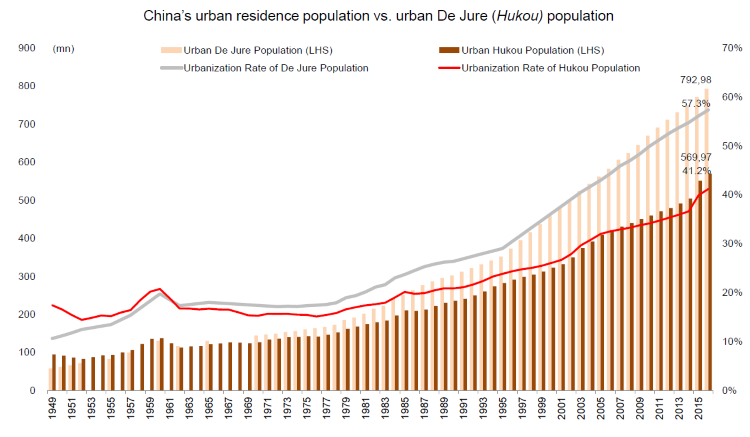Prior to joining the SKAGEN Kon-Tiki team in August this year, I spent time living and working in Shanghai, China. This article discusses some of the investment themes the country has to offer and provides an insight into the world's second largest growth engine, which offers significant long-term opportunities for the active investor.
Chinese growth is slowing
The evident slowdown in Chinese growth could be deemed to be positive. While historically, Chinese authorities have used credit supply as a relatively brute lever to spur growth, this is unlikely to prove sustainable over the long term. The uptick in nominal GDP growth in China over the last 18 months has instead been partly driven by supply side reform; the authorities have started to tackle chronic overcapacity, especially in upstream industries and have become increasingly serious about clamping down on companies that fail to meet environmental standards. As a result, nearly 5 years of producer price deflation came to an end in 2016, which in turn has helped reduce leverage on the balance sheets of corporates.
We are conscious, however, that the growth moderation is also in part due to the structurally lower additions to the Chinese labour force going forward, making continued urbanisation the key driver of economic growth.
Balance of growth is improving
While growth in China may be slowing, the balance of growth is improving. Tertiary industries – i.e. consumption and services rather than manufacturing and agriculture – are now the biggest components of economic growth.
In addition, so-called 'New Economy' industries are now receiving an increasing share of investment. According to CICC(1), consumption/services in aggregate already accounts for nearly 50% of fixed asset investment in China. We believe that this signals the ongoing shift of the economy towards a more sustainable consumption-led model that we are more accustomed to in the West.
Corporate leverage is key risk
The most common pushback to investing in China is excess leverage and the risk of a 'hard landing'. Whilst we are conscious of the risks stemming from the structure of China's financial system, we believe that the fear of a hard landing is somewhat overdone. The very fact that it has been an investment controversy for more than five years suggests that China's growth slowdown is, by definition, more of a 'soft landing'.
Moreover, we believe it is important to distinguish between corporate debt, which is very high by global standards, and household debt, which is relatively low (albeit rising). Through careful analysis, one can choose whether or not to invest in indebted companies and financial intermediaries, which reduces the risk to a portfolio, in our view.
With a strong culture for saving and relatively few options for long-term investment, we believe that Chinese consumers have significant capacity to take on more debt, most of which will be backed by residential property. As a result, it is likely that corporate leverage will, over time, be transferred to households through the property market.
Urbanisation still the key driver
As we argued above, we believe that the key long-term driver of the Chinese economy will be continued urbanisation. Although the cities may appear immense, according to the statistics, the official urbanisation rate with Hukou was only 41% at the end of 2016. Even including non-registered and migrant population brings the figure to only 57%, according to CICC, compared with around 80% in more developed markets.

Source: CICC as of September 2017
While there are 102 cities with over one million inhabitants, these only account for 23% of the population and cities with over five million inhabitants only constitute 11%(2). Therefore, China will continue to urbanise, creating new city clusters around the key metropolitan areas such as Shanghai and Beijing. This will require significant further investment in infrastructure as well as housing and environmental considerations.
World's most active stock market
The on-shore equity market (A-shares) offers plenty of ways to tap into the opportunities that China's transition has to offer. The Shanghai and Shenzhen stock markets together already represent the second largest stock market in the world with a market capitalisation of approximately USD 7 trillion(3). It is also the world's most actively traded large market with a turnover velocity of over two times per year, reaching as high as seven times per year for smaller capitalisation stocks. These high trading levels are due to the fact that the market continues to be dominated by retail investors who account for around 80-90% of activity in the A-share market.
The dominance of retail investors is also borne out by the relative lack of reliable consensus estimates in the A-share market. According to a 2016 UBS study(4), the distribution of sell-side estimates at the start of the year versus actual results reported is vastly different in A-shares and Hong Kong. Hong Kong exhibits a normal distribution of estimates around the actual results, suggesting that the predictive power of estimates is relatively good. The A-share market, however, shows a much flatter distribution, suggesting that consensus estimates have a much lower predictive power than in Hong Kong.
As a result, we believe that relying on third-party forecasts in the investment process for A-shares is unlikely to be of much value, putting more emphasis on independent analysis.
A market better reflecting China
Given the challenges and historical lack of access, one might therefore question the appeal of the A-share market. We believe there are two key reasons why global investors should consider A-shares. Firstly, they much better reflect where China is today and where it is heading. With an investment universe of well over 3,000 companies and a steady stream of IPOs, the opportunity set consists of many more younger, dynamic companies from new economy sectors than is the case in Hong Kong.
Secondly, we believe that many global investors are significantly underweight China and that allocations will increase over time. On average, overseas investors hold less than 3% of the A-share market, reflecting historical lack of access and scepticism towards the market. However, through the Hong Kong Connect system and upcoming MSCI inclusion for Chinese A-shares, we believe that this will (gradually) change.
Fundamentals play out
So what does this mean for SKAGEN? The structure of the Chinese A-share market in terms of retail investors, high levels of trading and the breadth of the market in terms of the number of stocks available, makes it ideally suited to active management and contrarian thinking, in our view. Whilst "value" as a factor has historically been somewhat cyclical in delivering outperformance, we believe that fundamentals are key and that growth tends to be somewhat over-valued by domestic investors. As a result, we believe that a focus on high quality franchises and industry structure will be key to delivering attractive risk-adjusted returns.
We are also conscious that so-called 'blue chips' have performed strongly over the past 18 months on the back of Hong Kong Connect opening up. This rerating of perceived quality stocks favoured by international investors may suggest that domestic investors are already anticipating the impact of global flows into A-shares. Nevertheless, we believe that there are ample opportunities for good absolute and relative performance on the back of the breadth of the market and SKAGEN's investment philosophy.
This is an abbreviated version of the original article by Fredrik Bjelland. Read the full article here (PDF).
References
1. Source: CICC, September 2017
2. Source: CICC, September 2017
3. Source: Bloomberg, October 2017
4. Source: Alpha Opportunities for Fundamental Investors, 5 December 2016
IMPORTANT INFORMATION
Except otherwise stated, the source of all information is SKAGEN AS as at 30 September 2017. Data has been obtained from sources which we deem reliable but whose accuracy is not guaranteed by SKAGEN.
Statements reflect the writer's viewpoint at a given time, and this viewpoint may be changed without notice. This article should not be perceived as an offer or recommendation to buy or sell financial instruments. SKAGEN AS does not assume responsibility for direct or indirect loss or expenses incurred through use or understanding of this article. Employees of SKAGEN AS may be owners of securities issued by companies that are either referred to in this article or are part of a fund's portfolio.




